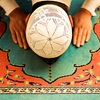Recently, my family was invited to share a meal with Alice Musumba and her husband, Tony—a young couple from Kenya, Africa. Before we sat at the table, Alice poured warm water over my hands while holding a bowl beneath to catch the overflow. I scrubbed my hands and dried them on the towel hanging from her arm. I waited while she repeated this for the other 13 people standing around the table.
After a prayer was offered for the meal, we all sat. We were offered ugali (boiled cornmeal), white rice, peanut stew, spinach, and collard greens. Alice described each dish for us and then recommended that we eat the way they would in Kenya—with our hands. At first, eating with my hands was awkward. I felt sloppy and uncoordinated. But, because I wasn't the only one doing it, I soon became comfortable scooping up rice and stew with a slice of ugali and licking the sauce off each one of my fingers.
I remember when I gave my heart to God and asked His Son Jesus to be my Savior. Accepting the invitation was easy, but living a life of following God's will for my life was a lot like being asked to give up my "utensils" for living. I was being asked to let go of my worries and wounds and trust God. I watched others, obviously more comfortable than me with these new ways, live their lives with a seemingly reckless abandon. When I first tried to follow the lead of other believers, I felt sloppy and out of control. But with practice and the graceful love of others, I'm learning to enjoy God's soul nourishment without having to use my tools of control as much as I used to.
This month, plan an ethnic meal (the ethnicity of one of your group member, if possible) and ask each group member to invite a person or couple. Spend some time researching the history and traditions of the meal you will prepare. Consider a meal that is eaten differently than a typical American meal:
- In Kenya, hand washing before the meal is a must since the food is eaten with the hands. The hostess provides the water, soap, and a towel to each guest. The meal is usually high in carbs and the targeted result is to feel full when finished eating. A prayer is always said before the meal.
- In China, many foods have symbolic meanings. Soup is considered a beverage. The meal often consists of many dishes, all served at once—family style. Chopsticks are the preferred utensils.
- Jamaican meals are a time for socializing and relaxing. Manners come second to enjoyment. The food is usually served all at once and a prayer is said before eating. Jamaicans eat a lot of seafood and use a variety of spices.
- Irish meals contain little to no spices. Hearty soups, made with a variety of meats, potatoes, and seafood are daily staples. Their everyday beverage is tea.
As a small group, have fun preparing the meal and praying for the time of eating and fellowship before the guests arrive. Explain the cultural traditions of your meal, and participate as much as possible. Focus on those that are centered on God. Continue to pray for your dinner guests in the days and weeks ahead and invite them to visit your small group.







